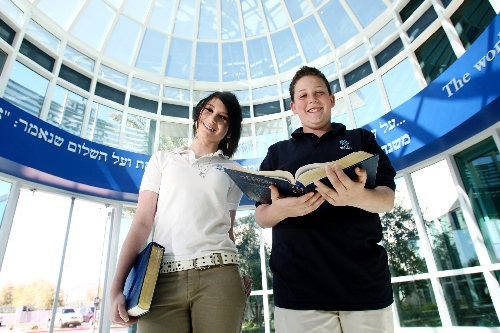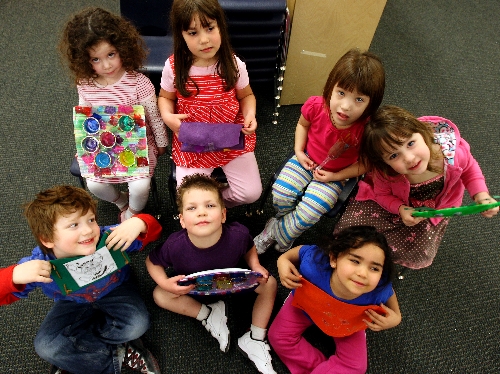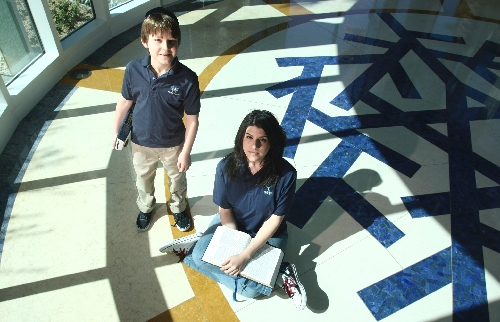Jewish youngsters learn Passover story has meaning for their lives today
This isn't their first Passover -- although it's not all that far from it -- and the children in Congregation Ner Tamid's early childhood education program already know a thing or two about matzo, that Passover dietary staple.
How to make the most of it, for instance.
"I like my matzo with butter," offers Ivy Markowicz, 3, although she says peanut butter on matzo isn't bad, either.
"I like matzos with jelly," says Tristan Valenti, 3, while Francesca Mendoza, 4, begs to differ.
"I like the matzo regular, because I don't like any stuff on it," she says.
Passover is a Jewish holiday that's kind of like matzo. It grows out of a historic event, but readily adapts to changing times and tastes. While adults may be happy to think of Passover the way they grew up with it, younger generations are apt to look at it through their own interpretive prism.
Passover, which this year begins at sundown Monday, commemorates the Jewish people's liberation from slavery. Its celebratory focal point is the Passover Seder, a meal at which symbolic foods -- including matzo, or unleavened bread -- are eaten and the story of the Jewish people's escape from Egypt is retold.
It's a story so deep and, yet, so simple that even preschool kids easily grasp it.
Why did the Jewish people have to flee Egypt? Because of the Pharaoh, answers Cassie Valenti, 5. "He was a mean Pharaoh. He wanted to kill the Jews."
Why? "I don't know," she answers. "And he wanted them to work all day and work all night."
Then, Cassie says, Moses went to the Pharaoh and "said, 'Please let my people go,' and he said, 'No, no.' "
Francesca picks up the story. "The fishes died in the water and the frogs jumped out of it and the water turned into blood."
"And," Cassie continues, "they got itchy from stuff all over them, like flies and stuff."
It's as vivid a retelling of the story as any. But, with age comes a greater appreciation of Passover's subtleties.
For example, while the underlying theme of Passover is the Jewish people's liberation from slavery, Sammy Lefkowitz, a seventh-grader at Adelson Middle School, says it's also about "how we survived so long under hard conditions and (how) we made it out as a strong group."
It marks the time when "we were first united as a people," Adelson Upper School senior Samantha Mayer adds.
Passover remains relevant today, notes Alexis Baranoff, an eighth-grader at Adelson, "because we are still fighting ... prejudice and people perceiving us as different. When we come together as a unified front, then we can fight battles better. And that's what we did in Egypt, (and) that we are still fighting today."
The Passover Seder offers a modern-day symbolic re-enactment of that historic event.
"Humans are very tangible creatures. They like to have something they can touch and taste and smell," Samantha explains. "So the Seder plate really is a tactile remembrance for our people to remember the slavery."
"Everything has meaning in our Passover," Alexis says: The horseradish that represents the bitterness of slavery, the matzo that recalls the dough that wasn't allowed to rise in the Jewish people's haste to flee, the haroset symbolizing "the mortar we used to build bricks in Egypt," and the parsley dipped in water representing "our tears, because we were crying out for God."
Jewish adults are commanded to retell the Passover story to their children, but they can do it as they see best. For example, Francesca says her mom has "a dinosaur Passover book." Sammy says his family tosses pingpong balls to represent the 10 plagues.
"Some of the steps in the Seder are just to keep kids awake," speculates Adelson fourth-grader Yoni Mayer, who is unrelated to Samantha. "We hide part of the matzo in our house and the kids have to try to find it."
Passover is "remembering the sorrow of what you went through, but it's also learning to be grateful for the fact that you're not a slave anymore," Samantha notes.
And that, she says, carries with it responsibilities that make the Passover story relevant today.
"God commands us to remember, 'You were once slaves in Egypt.' So, you look upon other people having hard times, and people who are enslaved or being oppressed, and we're supposed to look at them and help them and remember what was once done to us," she says.
Passover also is about strengthening the family and the Jewish community. Toward that end, Alexis says, "you can't deny anybody who is Jewish entry to your home on Passover, because you don't want to deny them their heritage. So if you have a friend or acquaintance who is Jewish, then you allow them into your house."
Samantha 's father is Catholic, so, she says, "I grew up with both religious traditions." At her home, "whenever we have a Seder, we invite people who aren't Jewish to come, just to experience it."
All agree that their nuanced understanding of Passover is the product of experience. Those who don't take the time to learn about it would probably consider it a "boring ritual," Alexis says.
For those who are committed, however, Passover and the traditions associated with it remain as alive and as vital as ever, they also agree.
"Each year, I find different meaning in it," Samantha says. "One thing about the holiday is, each year you find little things you didn't catch before. It's chock-full of symbolism and meaning, and it's like it's never ending. You never stop learning."
"That's the magic of Judaism," Alexis adds. "We have holidays and we can relate to them in modern-day life, and it's not just something that happened however many years ago. It's things we're dealing with now and how to deal with them better."
Contact reporter John Przybys at jprzybys@ reviewjournal.com or 702-383-0280.




















